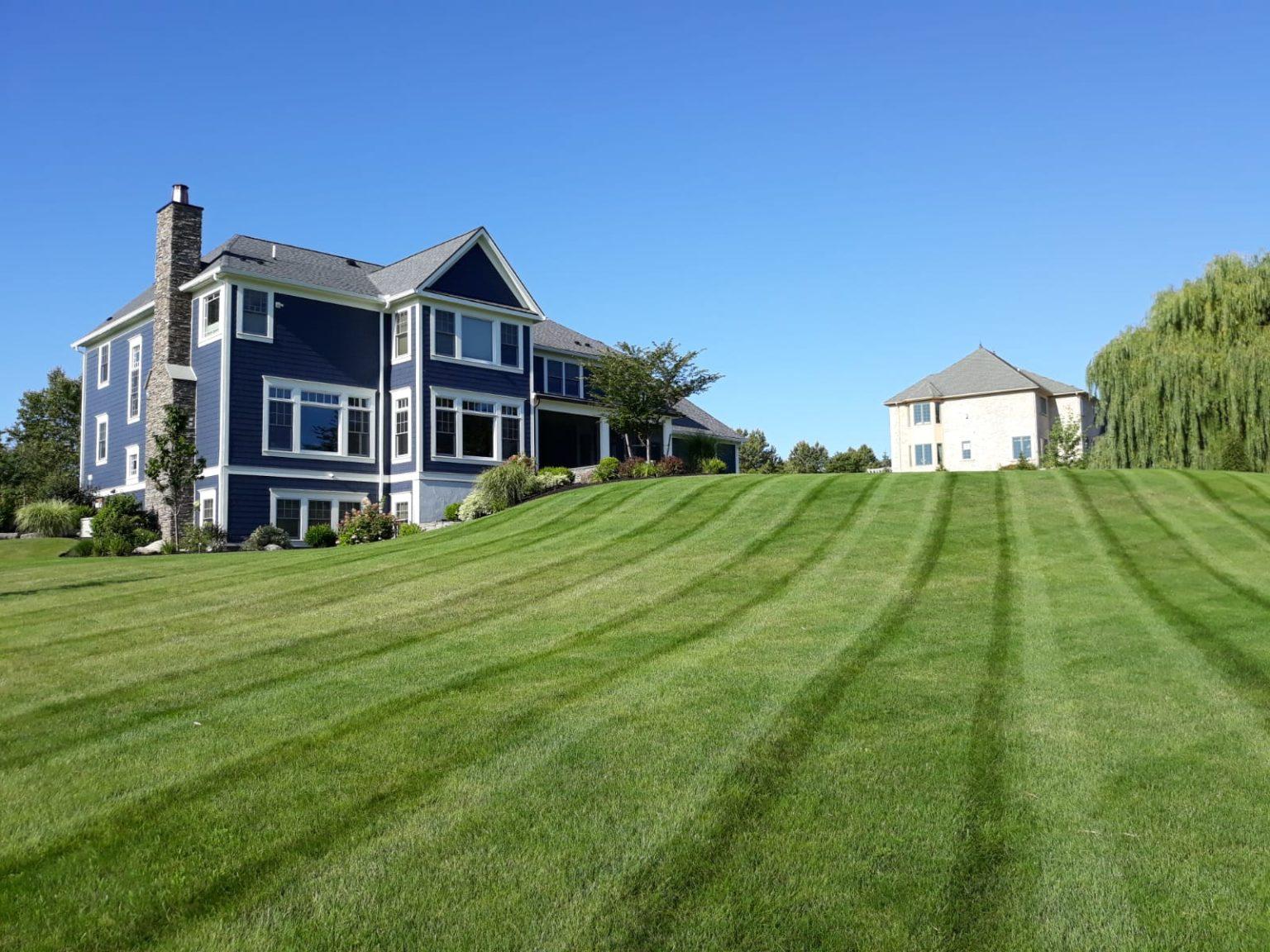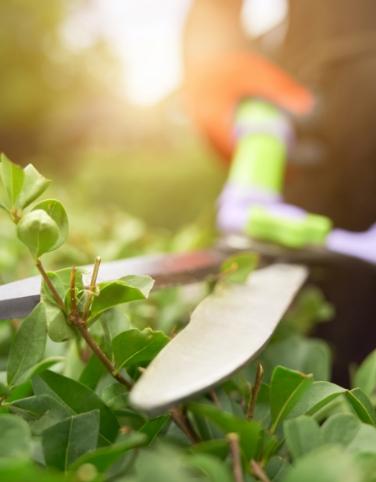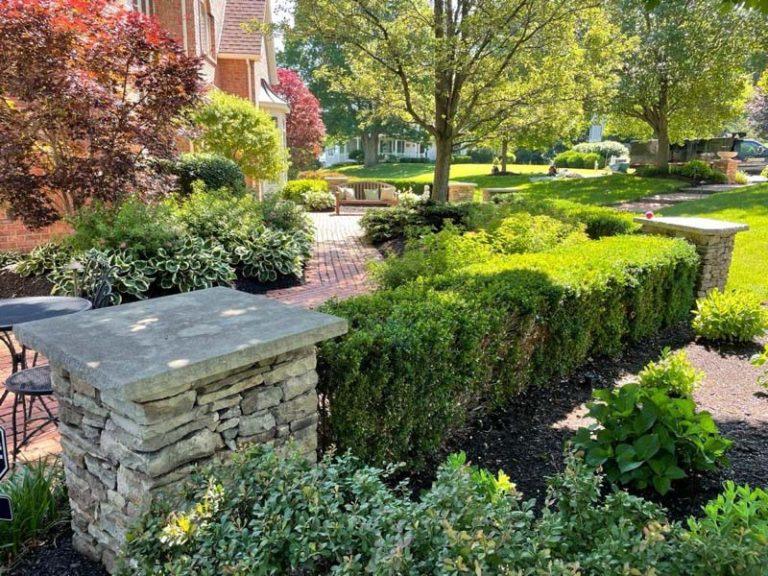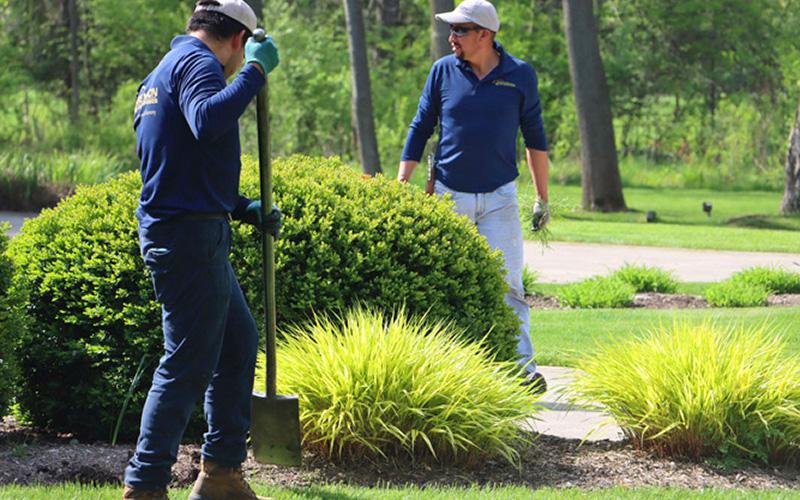

Our Services
Aeration and Overseeding
Achieve a Lush, Healthy Lawn with Aeration and Overseeding Services
Aeration and overseeding are two essential services that can transform your patchy grass into a lush, healthy lawn. At Benson Enterprises, we understand the importance of maintaining a vibrant and resilient landscape. A lawn can be the crowning glory, or its biggest eyesore. Benson Enterprises’ aeration and overseeding program can help ensure your lawn looks its healthy best all year long.
What is Lawn Aeration and Overseeding?
A great-looking lawn doesn’t just happen. It requires regular maintenance and care. Soil settles over time, which can result in something caused compaction. Foot traffic and heavy equipment can both contribute to pressing soil down. When that happens, air, water, and nutrients have a more difficult time reaching grass roots. This can result in stunted growth, patchiness, and an unhealthy lawn.
Lawn Aeration
Core lawn aeration involves the process of creating small holes in the soil. These holes help air, water, and nutrients get where they need to go. By improving access to these essential things, grass roots can grow deeper into the soil. That means your lawn will be healthier and more resilient.
Overseeding
Overseeding, on the other hand, involves spreading grass seeds over the existing lawn to fill in thin or bare patches caused by compaction. It helps make grass denser and allows you to integrate more robust grass varieties into your lawn.


Benefits of Core Aeration and Overseeding
- Aeration reduces soil compaction. Just as you wouldn’t try to plant a flower in concrete… a rock hard soil bed is not conducive to a great lawn either! Loose soil allows grass roots to plunge deeper into the soil to find vital water resources in times of stress.
- Aeration reduces thatch. Thatch is made up of grass stems and roots that accumulate faster than they breakdown. Excessive thatch creates an environment that is favorable to pests and disease.
- Aeration allows access to the root zone. By penetrating the soil, you’re allowing moisture, air, & food to the root zone where nutrients are absorbed.
- Aeration and seeding enhances seed germination. Seeds germinate easily in aerator holes as the holes provide them a place to hide.
- Overseeding introduces new grass seed to fill in bare or thin areas as well as thickening existing turf. Over time, grass plants reach their peak and need to be replaced. Different factors contribute to the breakdown of the grass including foot traffic, heat, lack of water, environmental conditions, pet waste, etc.
- Overseeding builds resistance to disease. By incorporating different blends of grass seed you reduce your risk to diseases that can wipe out the entire lawn as well as introduce new, stronger types of grass.
- Aeration and overseeding will help to reduce weeds. Opportunistic weeds germinate in areas where they can be successful. Crabgrass grows in thin areas, nutsedge pops up in thin/low spots, and broadleaf weeds spread where there is little desirable grass. The best defense is to have a thick established lawn.
- Aeration and overseeding will immediately improve your lawn’s current appearance. A good cultural practice is to aerate and over seed every year. This will help keep your lawn thick and healthy. You should see germination as soon as 7-14 days.
Improve your lawn’s health and appearance with aeration and overseeding.
How Often Should You Aerate Your Lawn in the Victor, NY Area?
How often you aerate your lawn depends on various factors. These include:
- Soil type
- Lawn usage
- Climate
The greater Rochester area consists primarily of Honeoye silt loam. Honeoye is a mix of silt, sand, and clay particles. Common grass varieties grow well in this soil type. However, it’s important to note that soil conditions can vary within a specific area. A soil test can determine the specific qualities of your lawn’s soil.
We generally recommended once a year lawn aeration and overseeding
However, if your lawn experiences heavy foot traffic, shows signs of compaction, or has a bigger percentage of clay in its soil, you might need to aerate more frequently. Our team of professionals can assess your lawn’s specific needs and recommend the ideal aeration schedule for you.
Signs That Your Lawn Needs Aeration
There are certain signs of poor lawn health that may mean it’s time to aerate:
- Compacted Soil: If you notice areas in your lawn where the soil feels unusually hard, it is likely time for aeration.
- Water Runoff and Puddling: When water can’t penetrate the soil and instead runs off or forms puddles, that suggests your lawn’s soil is too dense for healthy grass to grow.
- Thatch Buildup: Thatch is a layer of dead grass and organic matter that builds up between grass blades and the soil surface. It prevents water and nutrients from reaching grass roots. Aeration helps break down thatch and prevent its buildup.
- Dull-Looking Grass: If your lawn is thinning, has yellow patches, or just isn’t growing well, it may not be getting enough oxygen or nutrients. Aeration can revitalize a sick lawn, making it vibrant again.
Best Time of Year to Aerate Your Lawn
The optimal time to aerate your lawn in the greater Rochester area is during the fall or early spring. During these seasons, the soil is typically moist. This makes it easier for aeration equipment to penetrate the soil and reduces stress on grass plants. Additionally, aerating before or after the growing season allows the roots to take full advantage of the improved soil conditions.
Looking for Aeration and Overseeding?
Lawn Aeration and Overseeding Best Practices
To ensure successful aeration and overseeding, we follow these best practices:
- Water the Lawn: Before aeration, we will water your lawn thoroughly to soften the soil, making it easier for the aerator to penetrate
- Mow the Lawn: Prior to aeration and overseeding, we mow your lawn slightly shorter than usual. This helps the seeds to reach the soil surface.
- Overseed After Aeration: Immediately following aeration is the best time to overseed the lawn. By focusing on thin or bare areas, we maximize seed-to-soil contact. This increases the germination rate, giving you as much healthy new grass as possible.
- Proper Watering: We will instruct you on how to keep the soil consistently moist after overseeding. This supports seed germination and healthy lawn establishment. You should see germination as soon as 7-14 days.
Our Services




